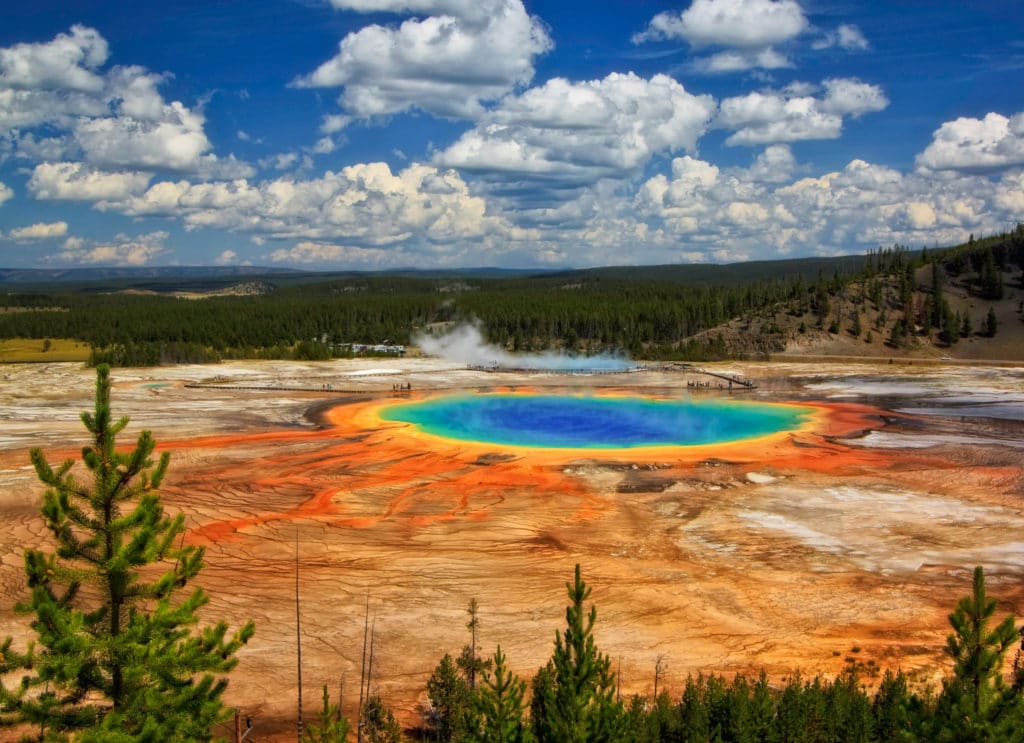Yellowstone National Park was established in 1872 as the first national park in the United States. Most of the park is in the state of Wyoming, although its north, northeast, and west entrances are in the bordering state of Montana. The park’s geothermal features, such as Old Faithful and Grand Prismatic Spring, draw millions of visitors to Yellowstone each year. But parkgoers also delight in the pristine alpine lakes, snow-capped mountains, and abundant wildlife.

Summer is the ideal time to visit the popular spot. Visiting the park in winter is not for the faint of heart, and those who look to brave the conditions must be well-prepared for all scenarios. The main forms of transportation in the park from November to March are snowmobiles and snowcoaches. In the summer months, weather changes in Yellowstone can catch visitors by surprise, as a dusting of June snowfall from the south entrance (on the outskirts of Grand Teton National Park) quickly becomes a trickling waterfall on your windshield as you head north. A visit to Yellowstone might mean you are wearing a heavy jacket one day, and a t-shirt the next.
One of the most enchanting aspects of Yellowstone is its ability to transport you from rocky mountains to rolling green hills to limestone-covered hot springs in a mere hour’s time. There is a lot to see, and many features you should stop and explore. The park houses a giant caldera, the result of a few large volcanic eruptions over the past two million years. One of the resulting features of the eruptions is Yellowstone Lake, the largest alpine lake in North America. But the park’s most distinguishing characteristics are its hot springs and geysers. Mammoth Hot Springs, in the northern area of the park, is a limestone-covered playground of thermal activity. The Grand Prismatic Spring, known for its spectacular array of colors, is the third largest hot spring in the world. The spring gets its rainbow effect from the varying water temperatures and high bacteria content of the spring. Old Faithful is arguably the park’s most famous feature. This tried-and-true geyser erupts approximately every hour and a half in the park’s Upper Geyser Basin.

Yellowstone’s scenery can make it nearly impossible to focus on driving, but taking your time is expected – the maximum speed limit varies depending on the area but is never more than 45 mph. Traffic can scroll for hundreds of yards while drivers wait patiently for a herd of bison to cross the road. You’ll want to keep an eye out for elk as well, as they are the most abundant animal in Yellowstone. An estimated 10,000-20,000 elk inhabit the park in the summer months. Among other animals likely to cross paths with visitors are moose, bighorn sheep, mule deer, and coyotes. Grizzly bears and gray wolves live in the park too, but their populations are much lower than some of the other animals. It is also common to spot smaller mammals like chipmunks, beavers, voles, and yellow-bellied marmots.
Accommodations in Yellowstone are limited to its nine lodges (open in the summer), offering cabins or hotel-style rooms, and in some cases both. There are also 12 campgrounds, with Fishing Bridge RV Park near the Yellowstone River being the only site that offers hookups for water, sewer, and electricity. Some visitors to the park choose to find lodging in outlying towns. Nearby West Yellowstone or Gardiner, both in Montana, are conveniently located near park entrances. About an hour from the east entrance, Cody, Wyoming is a popular area with a museum and other tourist attractions.
